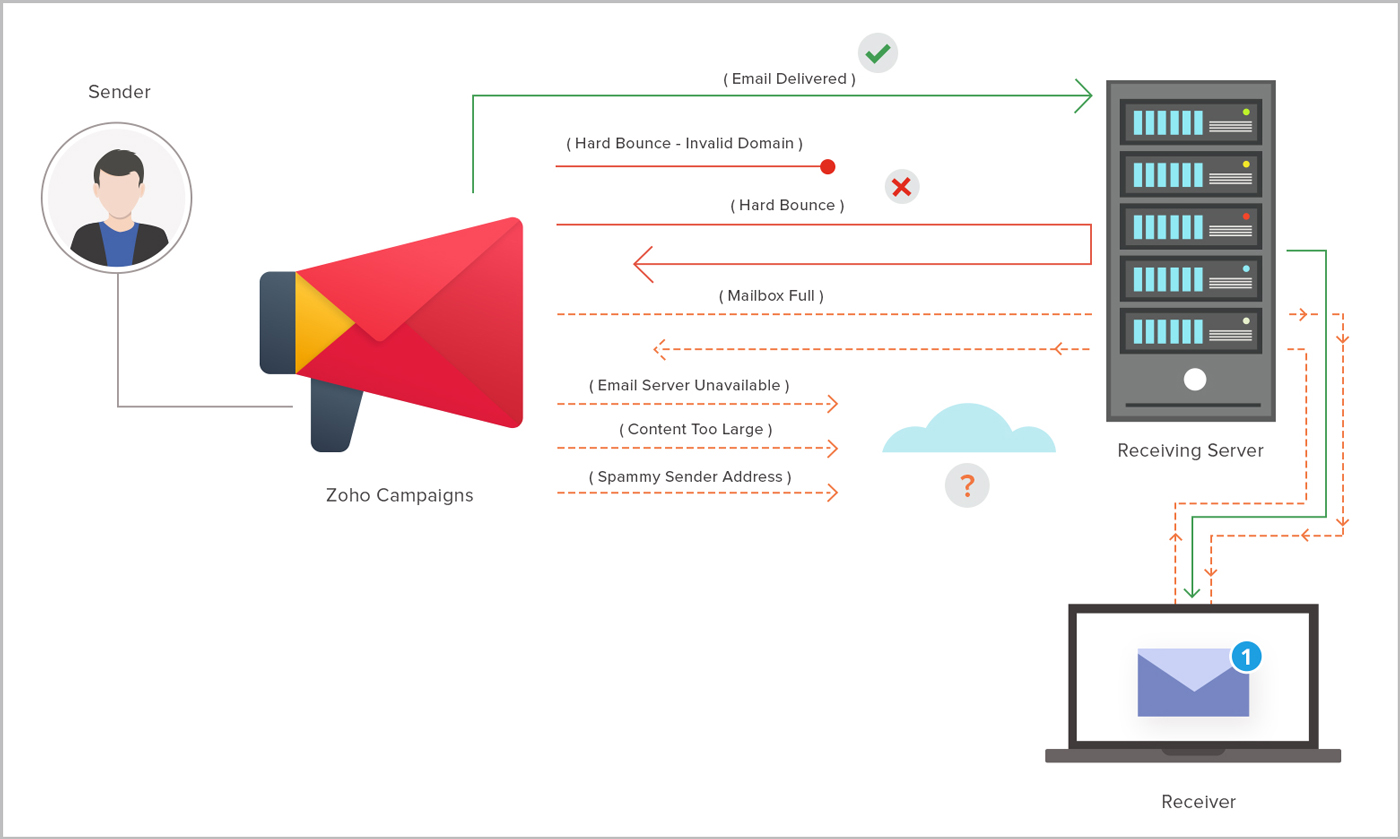Email Bounces Explained
Bounces occur when sent emails cannot be delivered. Typically, the email server will send you an error message, detailing the reason for the bounce. To learn more about this mechanism, let's walk through the process of sending an email and where bounces fit into the picture.


How are bounces generated?
Once an email is ready and the 'Send' button has been clicked, the system immediately looks up the recipient's domain and mail server. Once our system makes contact, the mail server looks at the message to determine if it will deliver the message. If the message passes through the mail server, then it is considered a success. If that server finds that the email address is invalid or does not exist, then the corresponding bounces will be returned back to our sender's server. This is called a 'hard bounce'.
If the recipient's email address exists but does not have enough storage space to accept the message, then it will bounce back to the sender as a 'soft bounce'. There is a possibility that these bounces may have occurred while the recipient system is busy or unable to handle requests. These emails will be retried within the next five days.
Our system will identify the mail delivery status based on the recipient system's response/status code/message, then generate a report for it.
Significance of bounce rates
Bounce rates are important to determine how many of your emails reach the contacts' inbox and how many don't. They also impact your domain reputation, so it's essential to keep an eye on your bounce numbers. Internet Service Providers (ISPs) and Email Service Providers(ESPs) set a certain threshold for bounce rates; exceeding that threshold may lead to a warning or account suspension.
At Zoho Campaigns, while sending a campaign, if the bounce rate exceeds 5%, we'll temporarily pause sending the campaign. We'll notify you about the campaign and resume sending the campaign after 24 hours. After we resume sending the campaign, if the emails bounce and if the bounce rate exceeds 5%, we will permanently cancel the campaign.
Bounce types
Bounces come in two categories: soft and hard bounces.
Soft bounces
A soft bounce is just a temporary delivery failure.It does not necessarily mean the email address is invalid or no longer active, so we will continue trying to send emails to these addresses.
These are a few common reasons for a soft bounce:
- Recipient's mailbox is full.
- Email server is temporarily unavailable.
- Email content is too large.
- Spammy content or blacklisted sender address.
In many cases, soft bounces are resolved on their own. Marketers should give utmost priority for these temporary failures in order to avoid a major breakdown in the future. A good marketer must have a plan to handle soft bounces.
If the emails sent to a particular address soft bounces around seven times, it will be considered a hard bounce, and that address will be added to the 'Bounced' list in order to preserve server and IP integrity.
Long story short, soft bounces = temporary deliverability failures.
Hard bounces
A hard bounce means there is a permanent reason for the delivery failure. Generally, the recipients' addresses are immediately added to the 'Bounced' list. Frequent hard bounces bring down the reputation of sending sources drastically.
Here are a few common reasons for an email's hard bounce:
- Recipient email address does not exist.
- Domain name does not exist.
- Typos render the email address invalid. (for example, gnail.com instead of gmail.com)
- Recipient email server has blocked delivery.
- The email address is inactive.
- Email account has been closed.
Hard bounces are quite serious. A raise in hard bounce rate badly affects your sender domain reputation with ESPs and ISPs, and may also lead to blacklisting of your email address.
Long story short, hard bounces = permanent deliverability failures.
How to avoid bounces
You can practice the following techniques to avoid email bounce:
- Don't use purchased mailing lists.
- Use the double opt-in technique to prevent the entry of invalid email addresses into your mailing list.
- Regularly clean your mailing list using email validation services.
- Don't use blacklisted URLs or spam trigger words in your email content.
- Ensure that your sender domain doesn't receive abuse complaints.
- Maintain optimal email volume and a healthy email frequency.
- Authenticate your sender domain.
Related Articles
Email Spam Traps Explained
Spam traps are used to identify which marketers are sending spam. A spam trap looks like a standard email address, but doesn't respond to emails or sign up for mailing lists, so when it receives an email, the sender is identified as a spammer. ...Zoho CRM Email Tools Overview
Introduction to Zoho CRM Email Efficiently nurturing potential customers and building strong relationships is a core function of CRM. While email serves as a primary customer interaction channel, using separate email and CRM systems can lead to ...Email Features Overview in Zoho CRM
Introduction to Email Efficiently nurturing potential customers and building strong relationships is a core function of CRM. While email serves as a primary customer interaction channel, using separate email and CRM systems can lead to challenges in ...Recent Zoho Enhancements to CRM Email Deliverability
Posted by Zoho: We're thrilled to talk about the enhancements that are coming up to improve Zoho CRM's email deliverability, as well as the systems we have in place today to support our customers' email communications. As you might know, our current ...Email Message Headers Overview
The following post will assist your understanding of email message headers, which can be helpful when troubleshooting why Zoho emails are landing in Spam Folders: Message headers give away some important details like: Source of an email (From ...